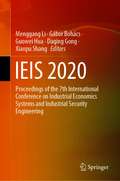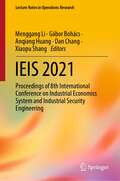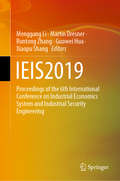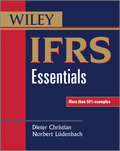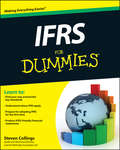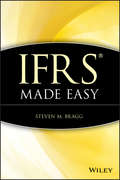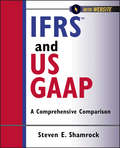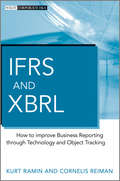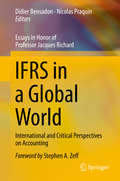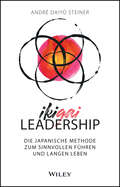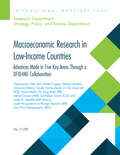- Table View
- List View
IEIS 2020: Proceedings of the 7th International Conference on Industrial Economics Systems and Industrial Security Engineering
by Menggang Li Guowei Hua Xiaopu Shang Gábor Bohács Daqing GongThis book contains selected papers of the International Conference on Industrial Economics Systems and Industrial Security Engineering (IEIS 2020), which is co-organized by Beijing Jiaotong University, Budapest University of Technology and Economics, in July 25–28 2020. This book aims to provide new research methods, theories and applications from various areas of industrial economics and engineering. In detail the included scientific papers analyze and describe communication processes in the fields of industrial economics, industrial system, industrial security and engineering and other related areas. The variety of papers delivers added value for both scholars and practitioners.
IEIS 2021: Proceedings of 8th International Conference on Industrial Economics System and Industrial Security Engineering (Lecture Notes in Operations Research)
by Menggang Li Dan Chang Xiaopu Shang Gábor Bohács Anqiang HuangThis book aims to provide new research methods, theories and applications from various areas of industrial economics and engineering. In detail, the included scientific papers analyse and describe communication processes in the fields of industrial economics, industrial system, industrial security and engineering and other related areas. The variety of the papers delivers added value for both scholars and practitioners. This book is the documentation of the IEIS 2021 conference. The book covers a great deal of research achievements in industrial restructuring strategy, industrial organization, industrial policy, departmental economic research, industrial competitiveness, regional industrial structure, national industrial economic security theory and empirical research, and it emphasizes on combining theory with practice. The book aims to discuss the issues in industrial economics and industrial security theories and practices. It is the documentation of IEIS 2021 conference, which took place at Shandong University. Due to the impact of COVID-19, it took place online as a virtual conference.
IEIS 2022: Proceedings of 9th International Conference on Industrial Economics System and Industrial Security Engineering (Lecture Notes in Operations Research)
by Menggang Li Guowei Hua Xiaowen Fu Dan Chang Anqiang HuangThis proceedings book selects a great deal of research achievements in industrial restructuring strategy, industrial organization, industrial policy, departmental economic research, industrial competitiveness, regional industrial structure, national industrial economic security theory, and empirical research, and it emphasizes on combining theory with practice. With the economic globalization, there have been many new phenomena, new situations, and new challenges in the industries in many countries. The proceedings aim to discuss the problems in industrial economics and industrial security theories and practices. It is the documentation of the conference “9th International Conference on Industrial Economics System and Industrial Security Engineering”. Due to the impact of COVID-19, IEIS2022 took place online as a virtual conference.
IEIS 2023: Proceedings of 10th International Conference on Industrial Economics System and Industrial Security Engineering (Lecture Notes in Operations Research)
by Menggang Li Xiaowen Fu Dan Chang Anqiang Huang Hua GuoweiThe proceedings volume is the documentary of IEIS 2023, held online on 26-28 July 2023. IEIS 2023 (International Conference on Industrial Economics System and Industrial Security Engineering), which is co-organized by Beijing Jiaotong University and The Hong Kong Polytechnic University, is a prime international forum for people involved in the conference in the world to discuss the problems in industrial economics and industrial security theories and practices. It aims to provide insights in solving the problems in national economy, social development and economic security. The conference theme is “Industrial development, industrial security and national economic security under the background of globalization”.
IEIS2019: Proceedings of the 6th International Conference on Industrial Economics System and Industrial Security Engineering
by Menggang Li Runtong Zhang Guowei Hua Martin Dresner Xiaopu ShangThis book presents a range of recent advances concerning industrial restructuring strategies, industrial organization, industrial policy, departmental economic research, industrial competitiveness, regional industrial structure, national industrial economic security theory and empirical research. Successfully combining theory and practice, the book gathers the outcomes of the “6th International Conference on Industrial Economics System and Industrial Security Engineering”, which was held at the University of Maryland, USA.
IFRS 16 and Corporate Financial Performance in Italy: An Empirical Post-Implementation Analysis (Contributions to Finance and Accounting)
by Elisa RaoliThis book presents an empirical analysis on how the new lease accounting model of IFRS 16 affects financial statements and performance of Italian companies. It discusses the theoretical framework of the off-balance sheet financing with a particular focus on the off-balance sheet lease contracts. Previous research provided controversial results about the potential impacts on the companies’ financial statement and performance deriving from leases capitalization. The application of different methodological approaches based on estimation of the expected effects resulted in inconclusive results. This book aims to measure the real impacts deriving from the post-implementation of the new lease accounting standard (IFRS 16) on companies’ financial statements, economic and financial performance, on market reactions and on financial statement’ users.
IFRS Essentials (Wiley Regulatory Reporting)
by Norbert Lüdenbach Dieter ChristianGain a deeper understanding of financial reporting under IFRS through clear explanations and extensive practical examples.IFRS can be a complex topic, and books on the subject often tackle its intricacies through dense explanation across thousands of pages. Others seek to provide an overview of IFRS and these, while useful for the general reader, lack the depth required by practitioners and students.IFRS Essentials strikes a balance between the two extremes, offering concise interpretation of the crucial facts supported by a wealth of examples. Problems and their solutions are demonstrated in a manner which is short, straightforward and simple to understand, avoiding complex language; jargon and redundant detail.This book is suitable for students and lecturers at universities and other educational institutions, auditing and accounting trainees, and employees in the area of accounting and auditing who seek to develop their practical skills and deepen their knowledge of IFRS.
IFRS For Dummies
by Steven CollingsThe easy way to get a grip on International Reporting StandardsIFRS For Dummies is your complete introduction to IFRS and international accounting and balancing standards. Combining all the facts needed to understand this complex subject with useful examples, this easy-to-read guide will have you on top of IFRS in no time.In plain English, it helps you make sense of IFRS and your understanding of: what they are and where they apply; how to adopt IFRS for the first time; how IFRS affects the key components of your financial statements; how to disclose information in financial statements; and much more.Covers what to do if you're applying IFRS for the first timeExplains complicated material in plain EnglishHelps you make sense of this principles-based set of standards that establish broad rules for financial reportingIf you're an accountant, student, or trainee in need of accessible information on IFRS, this hands-on, friendly guide has you covered.
IFRS Made Easy
by Steven M. BraggThe definitive guide to all things IFRS IFRS Made Easy provides complete, easy-to-navigate coverage of all International Financial Reporting Standards (IFRSs) with concise explanations and hundreds of supporting examples. This reference tool goes anywhere you go-to a client's office, on a business trip, or to an important lunch meeting, with on-the-spot answers to any questions that arise. Practical, plain -language explanation of the international financial accounting and reporting standards Summarizes International Financial Reporting Standards Liberally sprinkled with definitions and examples Notes applicable IFRS source documents Written for every company struggling with the impact of convergence, IFRS Made Easy clearly explains how IFRS will impact your company, how you will need to account for various specific items, and more. This book is filled with practical techniques and rules of thumb for understanding the day-to-day IFRS issues every accountant, controller or CFO is sure to face-and puts all the answers you need at your fingertips.
IFRS and US GAAP: A Comprehensive Comparison (Wiley Regulatory Reporting #7)
by Steven E. ShamrockA practical comparison of—and expert guidance on—IFRS and GAAP written by a practicing controller International Financial Reporting Standards (IFRS) are used in over 120 countries. US companies will inevitably encounter IFRS when evaluating the financial health of suppliers and customers. IFRS and US GAAP: A Comprehensive Comparison provides instruction in accounting under IFRS within the context of US accounting standards. Practical and easy-to-use, this book includes a case study of a first time IFRS adoption, emphasizing the much greater degree of professional judgment that is needed for IFRS. Provides a heavy emphasis on practical examples Includes an online companion website with downloadable spreadsheets and templates Reflects current financial reporting trends Addresses accounting requirements of which today's auditors, accountants and preparers of financial reports need to be aware Clarifying IFRS, its impact on US companies, and where to start in understanding it, IFRS and US GAAP prepares US accountants to be knowledgeable with day to day financial accounting issues using IFRS's substantial similarity with US GAAP as a context.
IFRS and XBRL
by Kurt Ramin Cornelis ReimanInternational Financial Reporting Standards are increasingly adopted worldwide, and it is critical to understand their place within the global business environment as well as the most up-to-date methods of applying them. In IFRS and XBRL Kurt Ramin and Cornelis Reiman, world authorities on IFRS, have condensed the overwhelming flood of available material to present a comprehensive guide to the key components of IFRS, helping to explain why they are a priority for private enterprises and governments alike. The book:provides valuable commentary on key components of IFRS which are crucial to local, national and international business decision makingdemonstrates the importance of disclosure checklistsoffers illustrative financial statements arising from IFRSlooks at recent developments in IFRS, in particular how the standards should be reflected in the narrative report, and what implications they have for sustainability reportingexplores how business reporting can be improved, for example through the addition of non-financial reportingexamines the key issue of emerging technology in reporting under IFRS, especially the use of XBRL and the obvious push for a new paradigm whereby object definitions, tracking and valuation offer considerable benefits to the people who produce and rely upon business reportsTo complete the picture, the authors examines other standards, and cover important issues such as US GAAP convergence with IFRS, and the important of International Valuation Standards, IFRS and XBRL is the complete guide to the background, current state, and future of International Financial Reporting Standards.
IFRS für Versicherer: Hintergründe und Auswirkungen
by Carsten ZielkeDieses Buch gibt einen umfassenden Überblick über Grundzüge und Auswirkungen der Neufassung des International Financial Accounting Standards für Versicherer. Zunächst werden dazu die wesentlichen Aspekte der Phase I beschrieben. Hier wird erkennbar, wie schon eine Fair-Value-Betrachtung der Aktivseite die Volatilität des Eigenkapitals erhöht. Daneben widmet sich Dr. Carsten Zielke Fragen der Rückversicherungspraxis, die ganz wesentlich vom IFRS beeinflusst werden wird. Bei der Betrachtung der Phase II beleuchtet er insbesondere die Auswirkungen auf Kapitalanlagepolitik, Produktgestaltung sowie die zukünftige Bewertung von Versicherungsunternehmen und legt dar, warum die Garantieprodukte der Lebensversicherung ein heikles Thema sein werden. Es werden Rückschlüsse auf eine langfristig sinnvolle Geschäftspolitik gezogen. Der Zusammenhang zwischen IFRS und Solvency II wird verdeutlicht.
IFRS in China
by Karthik Ramanna Nancy Hua Dai G. A. DonovanIn 2005, China announced plans to "converge with," but not completely adopt, IFRS. China also began to lobby for changes to specific IFRS provisions, such as for related party disclosures by state-owned firms, to bring them more into line with Chinese interests. China's accounting system had already undergone significant reforms during the two decades when its economy had grown to become the fourth largest in the world. However, enforcement of accounting standards remained weak, the financial system was relatively immature, and large state-owned firms still dominated many sectors of the economy.
IFRS in a Global World
by Didier Bensadon Nicolas PraquinThis book, dedicated to Prof. Jacques Richard, is about the economic, political, social and even environmental consequences of setting accounting standards, with emphasis on those that are alleged to be precipitated by the adoption and implementation of IFRS. The authors offer their reasoned critiques of the effectiveness of IFRS in promoting genuine global comparability of financial reporting. The editors of this collection have invited authors from 17 countries, so that a great variety of accounting, auditing and regulatory cultures, and educational perspectives, is amply on display in their essays.
IGAD and Multilateral Security in the Horn of Africa: Through the Lens of the Somali Conflict
by Adeoye O. Akinola Mohamed Farah HersiThis book offers an insightful and comprehensive exploration of the Inter-Governmental Authority for Development (IGAD) and its endeavours to foster economic and security regionalism in the dynamic landscape of the Horn of Africa. Established in 1986 as a drought-focused inter-governmental organization, IGAD has transformed into a sub-regional institution with an ambitious vision of promoting regional integration. However, amidst optimism, it grapples with historical, strategic, and geographical complexities that impede progress towards a more unified Horn of Africa. Adopting a political economy approach, the book critically dissects IGAD's role in shaping the zone's security and development. Employing multidisciplinary case studies, it unveils the reality of IGAD's efforts, providing a comprehensive understanding of its strengths and limitations. The book further applies neorealist and regional security complex theories, delving into the roles of states and non-actors, meticulously assessing IGAD's security agenda with Somalia as a focal point. This thought-provoking analysis brings to light the challenges and opportunities for sustainable regional integration. Beyond its academic significance, this book serves as a practical resource, offering sustainable policy templates to bolster regionalism and quell armed insurrections and inter-state conflicts within the Horn. Furthermore, it interrogates the geopolitics of the region, scrutinizing the involvement of foreign powers like the US and China, alongside regional giants like Ethiopia, in IGAD's security and economic aspirations. For researchers, policymakers, and stakeholders devoted to the Horn of Africa's development and reconstruction, this book proves to be an invaluable asset. It fills a significant void in existing literature, providing vital insights into African political development, peace, security, and security sector reforms.
II International Scientific Conference "Recent Advances in Architecture and Construction" 2024 (Lecture Notes in Civil Engineering #627)
by Nikolay Ivanovich Vatin Sergey Vasil'Yevich Klyuev Karina Rashidovna Nabiullina Venera Maratovna YumagulovaThis book gathers the latest advances, innovations, and applications in the field of construction engineering and architecture, as presented by researchers at the II International Scientific Conference “Recent Advances in Architecture and Construction”, held in Kazan, Russia, on May 14–15, 2024. It covers highly diverse topics, including engineering structures, advanced concrete technologies, durable structures, smart structures and materials, smart cities, architectural and environmental design, modern trends in the development of architectural typology, sustainable urban planning, built environment, construction technologies, and construction management. The contributions, which were selected by means of a rigorous international peer-review process, highlight numerous exciting ideas that will spur novel research directions and foster multidisciplinary collaborations.
IKEA Invades America
by Youngme MoonIn 2002, the IKEA Group is the world's top furniture retailer, with 154 stores worldwide. In the United States, IKEA operates 14 stores, all of which have been enormously popular despite their self-service requirements. The company's goal is to have 50 stores in operation in the United States by 2013. Explores various options for managing this growth strategy.
IKEA in Saudi Arabia (A)
by Karthik Ramanna Jerome Lenhardt Marc HomsyA Swedish newspaper reveals that IKEA has erased all images of women from its catalog for Saudi Arabia. The article sparks criticism of IKEA from the Swedish government and its customers in the West. Critics contend that IKEA is not living up to its own commitments to gender equality. Some threaten a boycott. IKEA must respond. Reissuing the catalog with women included risks running afoul of Saudi censors who can impose harsh penalties. The company has had a presence in Saudi Arabia for nearly 30 years.
IKEA in Saudi Arabia (B)
by Karthik Ramanna Jerome Lenhardt Marc HomsySupplement to case 116015. A Swedish newspaper reveals that IKEA has erased all images of women from its catalog for Saudi Arabia. The article sparks criticism of IKEA from the Swedish government and its customers in the West. Critics content that IKEA is not living up to its own commitments to gender equality. Some threaten a boycott. IKEA must respond. Reissuing the catalog with women included risks running afoul of Saudi censors who can impose harsh penalties. The company has had a presence in Saudi Arabia for nearly 30 years.
IKEA in Saudi Arabia (C)
by Karthik Ramanna Jerome Lenhardt Marc HomsySupplement to case 116015. A Swedish newspaper reveals that IKEA has erased all images of women from its catalog for Saudi Arabia. The article sparks criticism of IKEA from the Swedish government and its customers in the West. Critics content that IKEA is not living up to its own commitments to gender equality. Some threaten a boycott. IKEA must respond. Reissuing the catalog with women included risks running afoul of Saudi censors who can impose harsh penalties. The company has had a presence in Saudi Arabia for nearly 30 years.
IKEA's Global Sourcing Challenge: Indian Rugs and Child Labor (A)
by Vincent Dessain Christopher A. Bartlett Anders SjomanTraces the history of IKEA's response to a TV report that its Indian carpet suppliers were using child labor. Describes IKEA's growth, including the importance of a sourcing strategy based on its close relationships with suppliers in developing countries. Details the development of IKEA's strong culture and values that include a commitment "to create a better everyday life for many people." Describes how, in response to regulatory and public pressure, IKEA developed a set of environmental policies that grew to encompass a relationship with Greenpeace and WWF on forest management and conservation. Then, in 1994, Marianne Barner, a newly appointed IKEA product manager, is surprised by a Swedish television documentary on the use of child labor by Indian carpet suppliers, including some that supply IKEA's rugs. She immediately implements a strict policy that provides for contract cancellation if any IKEA supplier uses child labor. Then Barner is confronted by a German TV producer who advises her that he is about to broadcast an investigative program documenting the use of child labor in one of the company's major suppliers. How should she react to the crisis? How should the company deal with the ongoing issue of child labor in the supply chain?
IKIGAI-Leadership: Die japanische Methode zum sinnvollen Führen und langen Leben
by Andre Daiyu SteinerIn der heutigen, oft unsicheren Zeit sind viele Menschen vor allem auf der Suche nach Gleichgewicht und Sinn in ihrem persönlichen und beruflichen Leben. Die Mehrheit der vorallem jüngeren Arbeitnehmer wünscht sich, dass ihre Arbeit Sinn und Zweck hat und dass die Unternehmen, für die sie arbeiten, mehr wollen, als bloß Geld zu verdienen. Die Antwort darauf kann Ikigai sein - ein beliebtes japanisches Konzept, wie man ein glückliches und zielgerichtetes Leben führen kann. Es geht darum, dass Sie Ihre Essenz (wer Sie im tiefsten Inneren sind) und den Grund Ihres Hierseins (Ihren Zweck) in Harmonie mit Ihrer Tätigkeit erleben. André Daiyû Steiner überträgt deshalb in seinem Buch IKIGAI auf die Herausforderungen des heutigen Führungsalltags. Dabei stehen die vier zentralen Fragen des IKIGAI im Mittelpunkt: Worin sind Sie wirklich gut? Was machen Sie gerne? Was braucht die Welt? Wofür zahlt man Ihnen Geld? Diese vier wesentlichen Elemente bilden in ihrer Schnittmenge den IKIGAI. Ihre tiefsten Leidenschaften, Talente, sinnvollen Beiträge und die Bedürfnisse der Welt kommen zusammen und vermitteln ein Gefühl von Sinn und Erfüllung im (Arbeits-)Leben. Das Ergebnis: Sie sind zutiefst zufrieden und leidenschaftlich, bei dem was Sie tun und wie Sie führen. Sie werden durch einen Zustand des Flow getragen, der für neue Energie und Ausgeglichenheit sorgt.
IMF Departmental Paper (Departmental Papers)
by International Monetary FundA report from the International Monetary Fund.
IMF Departmental Paper: Advances Made In Five Key Areas Through A Dfid-imf Collaboration (Departmental Papers)
by International Monetary FundA report from the International Monetary Fund.
